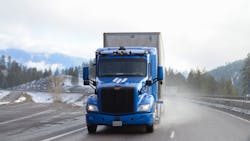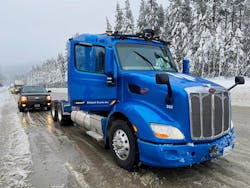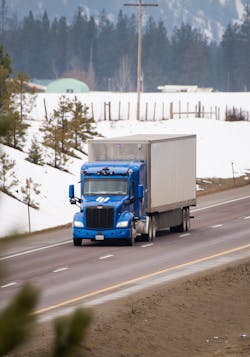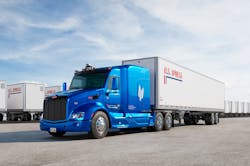Embark Trucks Advances Autonomous Driving Tech with Winter Testing and New Industry Partnership
Embark Trucks Inc., a subsidiary of Embark Technology Inc., is developing software to enable autonomous truck operation. Since its inception in 2016, the company has been working to advance its technology and partnering with members of the trucking sector to ensure its solution meets industry needs.
Embark Driver is the company's automated driving software which it describes as being sensor first and purpose-built for trucks. This sensor-first architecture enables real-time analysis and response to perception data and the use of Vision Map Fusion (VMF). VMF can dynamically adapt to changes in the environment around the truck.
Use of VMF for its system helps set it apart from other automated driving systems which often rely on the use of up-to-date high-definition (HD) maps provided by third parties. These maps can be outdated by the type a truck gets on the road and do not reflect real-time changes in the environment such as weather or construction.
VMF pairs maps and previous route experience with sensor data to enable adaptability to changing road conditions. Embark employs its patent-pending, nonlinear-optimization techniques to provide real-time map updates. LiDAR and camera sensors are utilized for visibility of road geometries.Also part of the system is the Embark Universal Interface (EUI) consisting of standardized components and flexible interfaces which make it easy for truck OEMs to integrate the autonomous system.
To ensure the performance and reliability of its system, Embark continues to conduct testing and form new industry partnerships. Most recently, the company announced completion of winter testing of the system and a partnership with logistics company U.S. Xpress.
Winter Testing Shows Safety Capabilities of Vision Map Fusion
In January 2022, Embark announced development of technology leveraging its VMF which would enable trucks equipped with Embark Driver to safely operate in snowy conditions. Although not initially part of the company's plans to commercialize its technology by 2024, it has already achieved several of its planned milestones and Embark wants to continually advance its system to meet varied needs of trucking fleets.
Embark began testing a truck equipped with its technology in February on a 60-mile route in Montana. The truck traversed various winter weather situations on public roads between Clinton and Missoula. The company says in its press release announcing results of the testing that in approximately 90% of runs through the snowy conditions under study – which could result in delays for HD map-based autonomous driving systems – VMF should operate successfully, or pause and resume travel within acceptable shipper delivery windows.Along with the on-road testing, Embark also developed a weather model using over 8 billion historical weather data points dating back over 10 years on all major U.S. routes to analyze the impact of snow at a lane level the company says in its press release.
The combination of on-road testing and historical data enabled Embark to determine its VMF can work within tolerance thresholds for safe operation in snowfall rates up to one-sixth inch per hour and with snow accumulation of 1 inch on the road over 3 hours the company states in its press release.
Snow conditions have been a challenge for other autonomous systems because the HD maps they utilize do not match with the actual environment.
Embark intends to continue studying and advancing its technology for these types of conditions as well as other associated ones such as sleet, ice and heavy winds.
U.S. Xpress Preparing Terminal Network for Autonomous Trucks
U.S. Xpress is the latest company to join the Embark Partner Development Program. Launched in 2021, the program helps the company refine its technology by partnering with transport carriers to get their input on necessary functions and features.
As part of the program, U.S. Xpress will add its terminals to the Embark Coverage Map which Embark notes in its press release announcing the partnership is a milestone for the company to have a fleet's properties added to an autonomous truck developer's transfer point network.
Embark established the transfer point model in 2019 with its first sites in Los Angeles and Phoenix. As Embark explains in its press release, transfer points are used to move freight from driverless long-haul trucks to driver-enabled trucks for fist- and last-mile delivery. This model allows drivers to be present in the areas where most needed such as urban areas where more challenging driving conditions occur. Drivers are likely to still be a necessity for navigating some freight yards or distribution centers as well, and for the paperwork associated with transporting goods, making this model beneficial to the industry.
Per Embark's press release, it will work with U.S. Xpress to identify priority terminals based on traffic patterns, customer needs, and technical requirements. The companies will start with two terminals in Sunbelt states—the region of the U.S. Embark is looking to first commercialize its technology—creating a clear path to opening a high-volume lane for autonomous hauling.
The companies will co-develop methods for onsite operations to help standardize the way autonomous trucks interact with U.S. Xpress' properties. Per Embark, the solutions developed will likely include:
- gate access,
- onsite vehicle movement,
- trailer swap procedures,
- inspections,
- data and power management, and more.
"Through our partnership with U.S. Xpress, we have identified a unique opportunity to leverage U.S. Xpress' existing truck terminals, unlocking a more seamless scaling process," said Alex Rodrigues, CEO of Embark, in the company's press release. "By utilizing existing truck terminals for transfer operations, Embark autonomous trucks will be able to more easily integrate with existing U.S. Xpress network assets such as last-mile driver capacity, parking, and maintenance services."
About the Author
Sara Jensen
Executive Editor, Power & Motion
Sara Jensen is executive editor of Power & Motion, directing expanded coverage into the modern fluid power space, as well as mechatronic and smart technologies. She has over 15 years of publishing experience. Prior to Power & Motion she spent 11 years with a trade publication for engineers of heavy-duty equipment, the last 3 of which were as the editor and brand lead. Over the course of her time in the B2B industry, Sara has gained an extensive knowledge of various heavy-duty equipment industries — including construction, agriculture, mining and on-road trucks —along with the systems and market trends which impact them such as fluid power and electronic motion control technologies.
You can follow Sara and Power & Motion via the following social media handles:
X (formerly Twitter): @TechnlgyEditor and @PowerMotionTech
LinkedIn: @SaraJensen and @Power&Motion
Facebook: @PowerMotionTech

Leaders relevant to this article:




